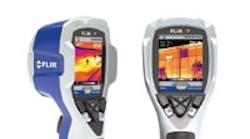Many manufacturers would be thrilled to have any double-digit revenue growth, but FLIR Systems is in the enviable position of predicting that will be case for its slowest-growing division.
If that seems boastful, FLIR has the track record to back up its predictions. Over the past five years, the company has had sales grow an average of 28% annually and earnings per share grew at a 35% annual rate. For the first nine months of 2009, FLIR saw revenue rise 8% to $835.5 million and the company expected full-year sales of some $1.15 billion.
FLIR Systems, headquartered in Wilsonville, Ore., has 2,000 employees and conducts business in more than 100 countries. The company manufactures thermal imaging infrared cameras for a growing array of markets, from preventive maintenance to firefighting to counter-terrorism. Unlike night vision equipment that amplifies low light sources, these cameras detect energy in the infrared spectrum invisible to the naked eye and turn it into an image. They can pick up minute temperature differences. For example, FLIR cameras are in use at airports to provide initial screening for people who may have H1N1 flu.
Unlike many firms that have vigorously outsourced their manufacturing, FLIR has pursued a vertical integration strategy. Tony Trunzo, senior vice president for corporate strategy and development, told a recent NASDAQ investor conference, "We believe in a high growth company [that] having control of our primary technologies is crucial and it has worked very well for us." Fueled by its 2004 acquisition of Indigo Systems, the company produces its own IR sensors, camera cores, coolers, lasers and optical lenses.
FLIR has pursued an aggressive research and development agenda, growing R&D spending 20% annually. Along with key acquisitions, this technology drive has allowed the company to expand into new markets, increase its manufacturing volumes and drive down costs. "Aggregation of volume allowed us to drive units up by 90% a year since 2005 and drive detector costs down by 30% a year," says Trunzo.
Commercial Opportunities
FLIR Systems' i7 thermal imaging infrared camera
Commercial Vision Systems is the smallest division at present with sales of approximately $200 million in 2009, but the company claims it offers the most growth potential. While FLIR has a high market share of the IR cameras used in automobiles, commercial buildings and emergency forces, it believes lower price points will bring the technology into much wider use. "Every firefighter will have an IR camera. Why? Because every firefighter should. It is an incredible piece of safety equipment," says Trunzo.
FLIR's Thermography division saw revenue decline in 2009, principally because of a fall-off in high-end products sold in the United States. The division produces primarily hand-held thermal imaging systems used for predictive and preventive maintenance, research and development, testing and measurement, and other applications. Trunzo predicts a rebound in this business based on higher unit volumes and FLIR's ability to lower prices.
FLIR expected to end 2009 with $400 million in cash. Trunzo says FLIR will use part of that money for "good strategic acquisitions." What about the reverse situation -- a major government contractor acquiring FLIR? Trunzo says with 40% of the company's revenue in commercial systems and a 15% to 20% annual growth path, FLIR's best plan is to stay independent.



